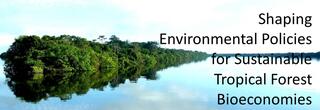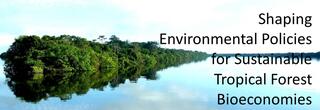Ecological and Economic Modelling of Conservation Policy
Ecological Modelling
Vegetation models are frequently used to study the effects of climate change on vegetation cover including related feedback relationships. Recent applications helped to improve our understanding of how tropical forest vegetation may respond to droughts and carbon fertilization. However, as tropical forest conservation policy becomes increasingly performance-based, for example in the context of REDD+, new fields of application for vegetation models emerge.
We are interested in using vegetation models to assess how tropical forest landscapes respond to policy induced land use changes in terms of key ecosystem service values at policy-relevant spatial and temporal scales. For example, latest-generation vegetation models allow us to simulate detailed carbon storage dynamics resulting from anthropogenic transitions within the landscape. Another application follows from modelling novel and transitional ecologies, using evolving vegetation traits and patterns, that can be used to valuate biodiversity.
To date, the protection of primary forest is the major focus of conservation policy. Alternatives arise in more fragmented, anthropogenic landscapes, in which edge effects can be a threat to primary forest existence or a chance for secondary forests restoration. A bio-physical assessment on secondary, degraded and fragmented forests is needed in which its worth in respect to biodiversity, nature conservation and climate mitigation can be quantified. Options in conserving or restoring forests can simultaneous result in improved or intensified production techniques within the landscape, leading to increased economic development. Linking the economic model with the latest vegetation models introducing anthropogenic need for natural commodities results in changing ecosystem services, and can present win-win scenarios in respect to ecology and economy.
Economic Modelling
Brazil’s remarkable success in curbing Amazon deforestation has been accompanied by a series of anecdotes and assumptions about the role of environmental policies in this process. Empirical evidence suggests that two major forces were at play: (1) a policy-induced increase in the effectiveness of existing regulatory measures and (2) increases in agricultural productivity. Standard evaluation and assessment tools are limited when it comes to understanding how potential synergies (e.g. land use restrictions stimulating agricultural intensification) and tradeoffs (e.g. conservation policy induced regional leakage) among these two forces affect land-use outcomes at policy-relevant spatial resolution. Spatially explicit models that operate at high resolution tend to lack either economic detail or appropriate scale; whereas economic models tend to use highly aggregated information and rely on strong assumptions with regard to policy compliance and implementation costs. We seek to develop economic modelling tools to bridge these gaps in the tool box for environmental economic impact assessments of tropical conservation policies. In particular, we are developing a structural economic model of agricultural production in Brazil to study how changes in economic conditions and environmental policies affect agricultural profitability, total output, resource and (forest) land demand. We expect this research to improve our understanding of the causal channels and country-wide implications behind currently low deforestation in the Brazilian Amazon. Moreover, the tools can be used to assess the viability and potential outcomes of various economic and environmental policy options currently under debate in Brazil and beyond, such as tradable land development rights, payments for environmental services schemes, and value chain governance initiatives. Interdisciplinary research questions related to specific ecosystem service outcomes of alternative policy scenarios will be addressed by integrated scenario analysis involving economic and ecological vegetation models.




